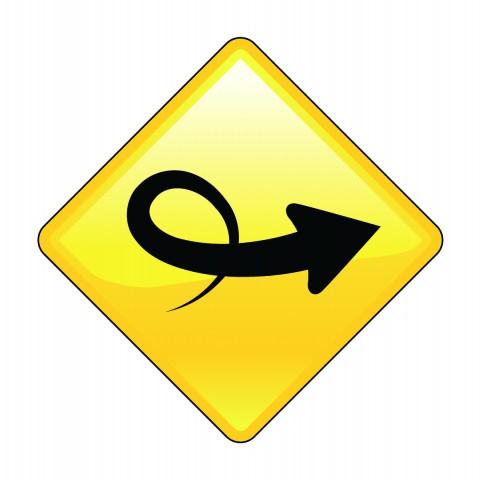
One of the most helpful things to keep in mind when acquiring an additional language is the importance of picking up patterns. Our brains, in a way, are very much like computers. They work much more efficiently if we can program them with patterns that have versatile applications, instead of trying to memorize every single instance of a given task.
In the case of learning Hebrew, picking up simple Hebrew sentence patterns is essential. This is because the task at hand is that of either producing or comprehending information (very often both), noting and correctly applying the ways in which it’s organized according to the patterns used in that language.
Hebrew sentence patterns, much like the בניינים (binyanim), or verb conjugation patterns, are certainly among the most useful building blocks you can acquire to help you as you work toward dominating the language. By learning how words are organized and combined to express different kinds of information, you’ll be able to plug the vocabulary you pick up into meaningful sentences and questions. In addition, you’ll be able to understand the same from Hebrew speakers in real life, or from texts, video, and audio.
In today’s lesson, we’re going to show you the top ten Hebrew sentence patterns most commonly used in everyday language. To keep it simple, we’ll focus on present tense only. If you master these easy Hebrew sentence patterns, you’ll quickly find yourself with a new given confidence in both speaking and understanding Hebrew.
Let’s jump right in!
 Table of Contents
Table of Contents
- Linking Two Nouns
- Using Adjectives to Describe Nouns
- Expressing Wants
- Expressing Needs
- Expressing Likes/Dislikes
- Making Polite Requests
- Asking Whether Something is Possible or Permitted
- Asking for Basic Information
- Asking the Time
- Asking for Location or Directions
- Turn Your Hebrew Lessons into a Pattern with HebrewPod101
1. Linking Two Nouns

Perhaps the most common sentence is that for linking two nouns (remember: people, places, and things).
Think of sentence patterns in English such as “I am Jon,” or “Jon is my neighbor.” These sentences are almost like a mathematical equation, where the verb “to be” is roughly equivalent to an “equal” sign (=).
Of course, this pattern is just as frequently used in Hebrew. However, there is an interesting difference. In Hebrew, we don’t use the verb להיות (lehiyot), or “to be,” in present tense. That being so, you merely need to say the two nouns you want to link, one after the other. Here are a few examples:
- אני דניאלה.
Ani Daniela.
“I am Daniela.”
- אני תלמיד.
Ani talmid.
“I [am] a student.”
*Note that Hebrew does not use indefinite articles, so, for instance, “a student” is just “student.”
In the case of the third person, there’s a variation worth noting in this pattern, in which we insert a personal pronoun between the two nouns we’re linking. This pattern is an acceptable alternative to that shown above, and doesn’t change the meaning at all. Using the last of the above Hebrew sentence examples, we can see the slight change:
- הכלב שלי הוא לברדור.
Ha-kelev sheli hu Labrador.
“My dog [is] a labrador.”
A similar pattern is where we link two nouns by way of a linking verb and what is called a predicative adjective. Think of these as a “roughly equivalent to” sign (≈). In this case, we’ll indeed use that verb in Hebrew. Here are a couple of examples:
- אתה נשמע כמו חייל.
Ata nishma kemo khayal.
“You sound like a soldier.”
- הכלב ההוא דומה לכלב שלי.
Ha-kelev ha-hu domeh la-kelev sheli.
“That dog looks like mine.”
- הסלט נראה טעים!
Ha-salat nireh ta’im.
“The salad looks tasty.”
2. Using Adjectives to Describe Nouns

Another very common sentence pattern in Hebrew is that which uses predicative adjectives to describe nouns with the verb “to be” linking the noun and the adjective. In this case, we’re not saying that one thing equals another; rather, we’re linking a certain attribute to it. Again, we’ll find that in Hebrew, unlike in English, the verb “to be” is absent in this pattern. Here are some examples:
- אתה גבוה מאוד.
Atah gavoha meod.
“You [are] really tall.”
- העוגה הזאת מתוקה.
Ha-ugah ha-zot metukah.
“This cake [is] sweet.”
- השירים האלה נעימים.
Ha-shirim ha-eleh ne’imim.
“These songs [are] pleasant.”
- הקפה טרי מאוד.
Ha-kafeh tari me’od.
“The coffee [is] very fresh.”
3. Expressing Wants

Another basic Hebrew sentence structure is that for expressing wants. In fact, there are two subcategories to look at here, specifically dealing with whether we want nouns or verbs. This is simply the difference between wanting a person, place, thing, or idea versus wanting to do, to have, etc.
In both cases, Hebrew uses the same main verb, לִרְצוֹת (lirtzot), meaning “to want.” Don’t confuse this with לְרַצּוֹת (leratzot), which means “to please” or “to satisfy.” Let’s have a look at both patterns, along with some helpful examples:
A. Want + Noun
- אני רוצה בירה.
Ani rotzeh birah.
“I want a beer.”
- אמא רוצה תה צמחים.
Ima rotzah teh tzmakhim.
“Mom wants an herbal tea.”
B. Want + Verb
- אנחנו רוצים לראות סרט.
Anakhnu rotzim lir’ot seret.
“We want to see a movie.”
- שלומי רוצה להזמין אותך לדייט.
Shlomi rotzeh lehazmin otakh le-deyt.
“Shlomi wants to ask you on a date.”
We can make these negative by simply inserting the word לא (lo) in front of the verb לרצות (lirtzot):
- אני לא רוצה בירה.
Ani lo rotzeh birah.
“I don’t want a beer.”
- אנחנו לא רוצים לראות סרט.
Anakhnu lo rotzim lir’ot seret.
“We don’t want to see a movie.”
4. Expressing Needs

We all know that sometimes we don’t just want something, we need it. This is certainly an essential pattern to learn for whenever you need to express an urgent necessity, or even an emergency. Again, we’ll look at two subcategories here, namely those for needing nouns and needing verbs. Once more, the verb is going to be the same in both cases: להצטרך (lehitztarekh), meaning “to need” or “to have to.” Here are some examples of both patterns:
A. Need + Noun
- רונית צריכה את העזרה שלך.
Ronit tzrikhah et ha-ezrah shelkha.
“Ronit needs your help.”
- אני צריך אוטו חדש.
Ani tzarikh oto khadash.
“I need a new car.”
B. Need + Verb
- הממשלה צריכה לעזור לנזקקים.
Ha-memshalah tzrikhah la’azor la-nizkakim.
“The government has to help the impoverished.”
- אני צריך לאכול עכשיו.
Ani tzarikh le’ekhol akhshav.
“I need to eat now.”
Again, making a negative statement is as simple as inserting the word לא (lo) before the verb להצטרך (lahitztarekh):
- רונית לא צריכה את העזרה שלך.
Ronit lo tzrikhah et ha-ezrah shelkha.
“Ronit doesn’t need your help.”
- אני לא צריך לאכול עכשיו.
Ani lo tzarikh le’ekhol akhshav.
“I don’t need to eat now.”
5. Expressing Likes/Dislikes

Another pattern you’re more than likely to find yourself wanting to use in Hebrew is that for expressing your likes and dislikes. Again, we have two subcategories: like/love + noun and like/love + verb.
One interesting, and perhaps rather strange, aspect of the Hebrew language is that it doesn’t use different verbs to distinguish between liking something/someone and loving it or him/her. So just keep that in mind when you use this pattern. Generally, the context and/or the tone of voice you employ will make the degree of your enthusiasm clear. However, when you use the verb in question, לאהוב (le’ehov), meaning “to like” or “to love,” with a person as the object, it almost always means “to love.” So make sure you mean it if you’re going to say it!
A. Like/Love + Noun
- אני אוהבת שוקולד.
Ani ohevet shokolad.
“I like/love chocolate.”
- הילדים שלי אוהבים סרטי דיסני.
Ha-yeladim sheli ohavim sirtey Disni.
“My kids like/love Disney movies.”
B. Like/Love + Verb
- חברה שלי אוהבת לאפות לחם.
Khaverah sheli ohevet le’efot lekhem.
“My girlfriend likes/loves to bake bread.”
- דני אוהב לשחק שחמט.
Dani ohev lesakhek shakhmat.
“Danny likes/loves to play chess.”
And you guessed it! To make these statements negative, all we need to do is add the word לא (lo) before the verb לאהוב (le’ehov). Note that, as in English, we don’t usually say that we don’t love, but rather that we don’t like either a noun or a verb:
- אני לא אוהבת שוקולד.
Ani lo ohevet shokolad.
“I don’t like chocolate.”
- דני לא אוהב לשחק שחמט.
Dani lo ohev lesakhek shakhmat.
“Danny doesn’t like to play chess.”
6. Making Polite Requests

Yet another common pattern that can be immensely helpful is that for making polite requests. This is particularly helpful when we’re asking something of a person we don’t know well, such as asking a stranger for directions or the time.
Let’s look at two Hebrew language sentence structure possibilities here: one using an imperative with the word בבקשה (be-vakashah) or “please” attached to it, and the other an indirect question.
A. Imperative + בבקשה (be-vakashah)
- אמור לי בבקשה מהו שמך.
Emor li be-vakashah mahu shimkha.
“Please tell me what your name is.”
- העבר לי בבקשה את המלח.
Ha’aver li be-vakasha et ha-melakh.
“Please pass me the salt.”
* An important note here is that many, if not most, speakers of modern Hebrew use the future form instead of the imperative. While this isn’t technically correct from a grammatical standpoint, it’s so prevalent that one might even say it’s more natural-sounding than the correct form. Here’s what the above examples would look like using this variation:
- תאמר לי בבקשה מהו שמך.
Tomar li be-vakashah mahu shimkha.
“Please tell me your name.” (Literally: “Please, you will tell me your name.”)
- תעביר לי בבקשה את המלח.
Ta’avir li be-vakasha et ha-melakh.
“Please pass me the salt.” (Literally: “Please, you will pass me the salt.”)
As in English, we can also shift the position of the word בבקשה (be-vakashah) to the end of the sentence, without changing the meaning in any way:
- אמור לי מהו שמך בבקשה.
Emor li mahu shimkha be-vakashah.
“Tell me your name, please.”
- העבר לי את המלח בבקשה.
Ha’aver li et ha-melakh be-vakasha.
“Pass me the salt, please.”
B. Indirect Question Using the Future Tense
- האם תוכל לומר לי מה השעה?
Ha’im tukhal lomar li mah ha-sha’ah?
“Could you tell me the time?”
- האם תוכלי לעזור לי עם שיעורי המתמטיקה?
Ha’im tukhli la’azor li im shi’urey ha-matematikah?
“Could you help me with the math homework?”
There are a couple of possible variations here. For one thing, the word האם (ha’im), roughly equivalent to the modal “could” or “would” in English, is optional. Additionally, for extra politeness, we can add in the word בבקשה (be-vakashah) to the same pattern, generally at the very end of the question:
- תוכל לומר לי מה השעה, בבקשה?
Tukhal lomar li mah ha-sha’ah, be-vakashah?
“Could you tell me the time, please?”
- תוכלי לעזור לי עם שיעורי הבית במתמטיקה, בבקשה?
Tukhli la’azor li im shi’urey ha-bayit be-matematikah, be-vakashah?
“Could you help me with the math homework, please?”
7. Asking Whether Something is Possible or Permitted

Needing to ask permission is yet another situation that’s bound to come up in daily language usage. Let’s take a look at two types of Hebrew phrases for doing this. The first pattern, using אפשר (efshar), is more general, and can be used for asking about whether something is possible (though in certain contexts, it’s also used to ask about permissibility). The second, using מותר (mutar), is used specifically to ask if something is permitted.
A. Asking Whether Something is Possible
We can use the word אפשר (efshar) before a noun to make a basic request, or before a longer question for more complex requests. This form is rather flexible, and can even be used as an alternative way of making a polite request. This is similar to saying “Would it be possible…” in English.
- אפשר אש?
Efshar esh?
“Might I have a light?” (Literally: “Is a light possible?”)
- אפשר לקבל מים בבקשה?
Efshar lekabel mayim be-vakashah?
“Could I have some water, please?”
- אפשר פיצה גדולה עם הכל?
Efshar pitzah gedolah im hakol?
“Could I have a large pizza to go?”
- אפשר להזמין את הפריט במשלוח מהיר?
Efshar le-hazmin et ha-parit be-mishlo’akh mahir?
“Is it possible to order the item with express shipping?”
- אפשר לומר לך משהו בארבע עיניים?
Efshar lomar lakh mashehu be-arba eynayim?
“Could I tell you something in private?” (Literally: “Could I tell you something with four eyes?”)
B. Asking Whether Something is Permitted
- מותר לצלם כאן?
Mutar letzalem kan?
“Are pictures allowed here?” (Literally: “Is it permissible to take pictures here?”)
- מותר להשתמש במילון בזמן המבחן?
Mutar lehishtamesh be-milon bi-zman ha-mivkhan?
“Are we allowed to use a dictionary during the exam?” (Literally: “Is it permissible to use a dictionary during the exam?”)
- מותר לנסוע באוטו בשבת אם אני לא נוהג?
Mutar linso’a’ be-oto be-Shabat im ani lo noheg?
“Is it permissible to travel by car on Shabbat if I am not driving?”
8. Asking for Basic Information

Being able to ask for information is, of course, always useful—and in many cases, vital. Luckily, this is another very simple Hebrew sentence structure that’s easy enough to internalize so that you can use it when you need to.
All we need here is to know our interrogative and personal pronouns in Hebrew to form quick and simple questions for asking basic information. Note, again, the absence of the verb “to be” in these questions. Let’s see some examples:
- מה זה הדבר הזה?
Ma zeh ha-davar ha-zeh?
“What [is] that thing?”
- מה זה להתבונן?
Mah zeh lehitbonen?
“What [is] ‘contemplating’?” / “What does ‘to contemplate’ mean?”
- מי זה הבחור ההוא?
Mi zeh ha-bakhur ha-hu?
“Who [is] that guy?”
- מי זאת ריהאנה?
Mi zot Rihana?
“Who [is] Rihanna?”
Note that when referring to a single person by a description rather than a proper name, we can use either the pronoun זה/זאת (zeh) or הוא/היא (hu/hi), depending on gender. That said, we generally use the second option for males, and not very often for females. For example:
- מיהו הבחור ההוא?
Mihu ha-bakhur ha-hu?
“Who [is] that guy?”
Additionally, when asking questions about people, we can omit the personal pronoun entirely without changing the meaning of our question. For instance:
- מי הבחור ההוא?
Mi ha-bakhur ha-hu?
“Who [is] that guy?”
9. Asking the Time

It’s quite common to find ourselves asking the time, say, if our phone’s battery dies or if we’re visiting Israel and haven’t yet adjusted our clocks to the local time zone. Let’s look at a basic pattern for asking the time. In addition, we’ll see another pattern we can use to ask for the time that something is set to occur.
A. Asking the Time
- מה השעה?
Mah ha-sha’ah?
“What time is it?”
B. Asking When Something is Going to Occur
- מתי יום ההולדת שלך?
Matay yom ha-huledet shelkha?
“When is your birthday?”
- מתי מתחיל הסרט?
Matay matkhil ha-seret?
“When does the movie start?”
- מתי אנחנו חוזרים הביתה?
Matay anakhnu khozrim habaytah.
“When are we going home?”
10. Asking for Location or Directions

The final pattern that we’ll look at today is useful for asking for information pertaining to the location of something (or directions, if that place or thing is far from our current location). Once again, the verb “to be” is omitted.
- איפה השירותים?
Eyfoh ha-sheyrutim?
“Where [is] the bathroom?”
- איפה התחנה המרכזית?
Eyfoh ha-takhnah ha-merkazit?
“Where [is] the central bus depot?”
- איפה המפתחות שלי?
Eyfoh ha-maftekhot sheli?
“Where [are] my keys?”
An alternative pattern we can use here is created by simply adding the verb להימצא (lehimatze), meaning “found” or “located,” after the question word איפה (eyfoh), meaning “where.”
- איפה נמצאים השירותים?
Eyfoh nimtza’im ha-sheyrutim?
“Where [is] the bathroom found?”
- איפה נמצאת התחנה המרכזית?
Eyfoh nimtzet ha-takhnah ha-merkazit?
“Where [is] the central bus depot located?”
11. Turn Your Hebrew Lessons into a Pattern with HebrewPod101

We really hope you’ve found these common Hebrew sentences and question patterns informative and useful. By simply picking up a few patterns, you can go ahead and plug in the vocabulary you want to create myriad sentences and questions of your own. To use them correctly, just focus on which elements are fixed, which need to be conjugated or gendered, and which are totally free to be replaced with the information you wish to insert.
So go ahead and start by practicing the examples given here, then use them to make your own examples for each of the ten categories we’ve seen. In no time, you’ll have added a huge amount of variety and flexibility to your Hebrew skills, thanks to these handy patterns.
Our goal, as always, is to make your learning experience fun, effective, and interesting. Feel free to get in touch with us and let us know if there are any other Hebrew sentence patterns you want to know, or if you need any further examples in the categories we covered. HebrewPod101 is here to help you develop your Hebrew and enjoy yourself as you progress! We’re always happy to hear from you along the way.
Shalom!










